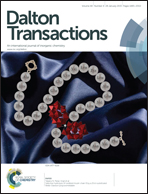Structure and water exchange dynamics of hydrated oxo halo ions in aqueous solution using QMCF MD simulation, large angle X-ray scattering and EXAFS†
Abstract
Theoretical ab initio quantum mechanical charge field molecular dynamics (QMCF MD) has been applied in conjunction with experimental large angle X-ray scattering (LAXS) and EXAFS measurements to study structure and dynamics of the hydrated oxo chloro anions chlorite, ClO2−, chlorate, ClO3−, and perchlorate, ClO4−. In addition, the structures of the hydrated hypochlorite, ClO−, bromate, BrO3−, iodate, IO3− and metaperiodate, IO4−, ions have been determined in aqueous solution by means of LAXS. The structures of the bromate, metaperiodate, and orthoperiodate, H2IO63−, ions have been determined by EXAFS as solid sodium salts and in aqueous solution as well. The results show clearly that the only form of periodate present in aqueous solution is metaperiodate. The Cl–O bond distances in the hydrated oxo chloro anions as determined by LAXS and obtained in the QMCF MD simulations are in excellent agreement, being 0.01–0.02 Å longer than in solid anhydrous salts due to hydration through hydrogen bonding to water molecules. The oxo halo anions, all with unit negative charge, have low charge density making them typical structure breakers, thus the hydrogen bonds formed to the hydrating water molecules are weaker and more short-lived than those between water molecules in pure water. The water exchange mechanism of the oxo chloro anions resembles those of the oxo sulfur anions with a direct exchange at the oxygen atoms for perchlorate and sulfate. The water exchange rate for the perchlorate ion is significantly faster, τ0.5 = 1.4 ps, compared to the hydrated sulfate ion and pure water, τ0.5 = 2.6 and 1.7 ps, respectively. The angular radial distribution functions show that the chlorate and sulfite ions have a more complex water exchange mechanism. As the chlorite and chlorate ions are more weakly hydrated than the sulfite ion the spatial occupancy is less well-defined and it is not possible to follow any well-defined migration pattern as it is difficult to distinguish between hydrating water molecules and bulk water in the region close to the ions.


 Please wait while we load your content...
Please wait while we load your content...